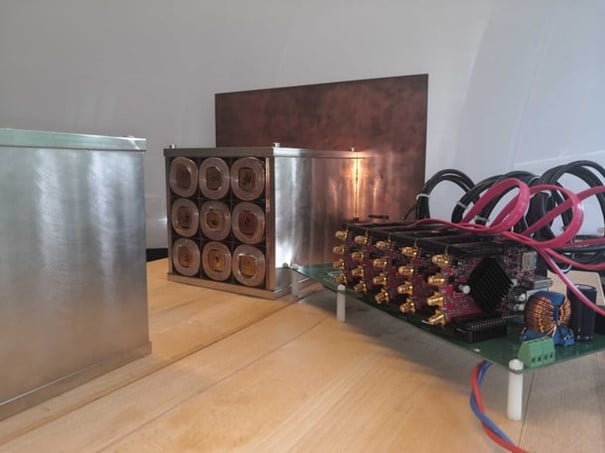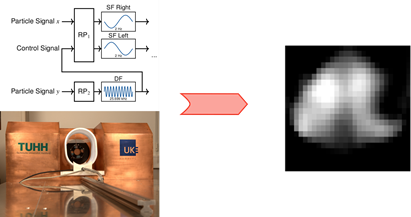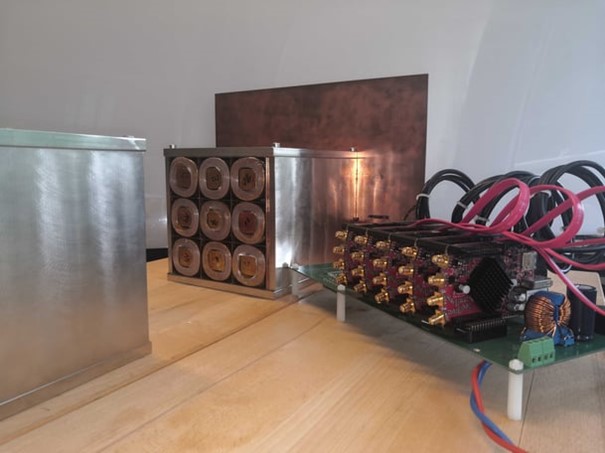Multi-Channel Signal Acquisition and Generation for Magnetic Particle Imaging with Red Pitaya
-
Posted by
 Red Pitaya Team
, September 27, 2023
Red Pitaya Team
, September 27, 2023

Tomographic imaging modalities, such as magnetic resonance imaging (MRI) or computed tomography (CT), have become a central part of the clinical routine and are vital for the diagnosis of diseases and health problems. The scanners for these techniques are complex distributed systems, that use physical effects to produce an image from the inside of a patient. The imaging processes themselves require complex sequences that use synchronous multi-channel signal generation and reception.
Magnetic Particle Imaging is a new tracer based imaging modality, where the concentration of pre-administered tracers within the bloodstream is determined. The tracer material consists of super paramagnetic iron-oxide nano particles that are constantly remagnetized in an alternating magnetic field. Due to the nonlinear relationship between the particle magnetization and the exciting field, harmonics of the exciting fundamental wave are generated by the tracer. These harmonics can be measured and used to infer the tracer concentration. Even other physical quantities, such as temperature or viscosity of the tracer and therefore its surrounding material, can be determined. An example for potential applications for MPI is the visualization of blood flow for the diagnosis of artery diseases or functional brain imaging.
One of the major goals of current MPI research is upscaling the technology onto the human scale. The Institute for Biomedical Imaging at the University Medical Center Hamburg-Eppendorf (UKE) and the Hamburg University of Technology (TUHH) works on these goals in various algorithmic and experimental research projects. Together with their open software stack (RedPitayaDAQServer), they used the STEMlab 125-14 X-Channel to implement a scalable and flexible signal generation and acquisition system that is used in their research.
One project is the development of a human-sized magnetic particle imaging scanner for brain applications. During measurements, this scanner applies two different magnetic fields: a gradient field (called “selection” and “focus” field, SF) and a time-varying field (called “drive” field, DF). For these fields, the respective control signals must be sent to the amplifiers that supply the field-generating coils. Additionally, the scanner also records the particle and feedback signals in parallel.

Figure 1: Overview of brain scanner: Top left shows the Red Pitaya setup, bottom left shows the developed MPI scanner. On the right is a reconstructed brain perfusion experiment from a brain phantom/model.
As shown in Figure 1, the scanner uses multiple Red Pitaya devices at the same time to generate and acquire the necessary signals. The STEMlab 125-14 X-Channel System (https://redpitaya.com/product/stemlab-125-14-x-channel-system/) allows for synchronization with a common clock and trigger. The base board on which the X-Channel System is built features a Xilinx Zynq 7010 with a dual ARM Cortex A9 and FPGA. It features two RF inputs and two RF outputs that can sample signals at 125 Msps with 14-bit resolution. It also features Ethernet Gigabit connectivity, USB host capability and extension connectors to add more hardware features and functions.
Another project, that uses STEMlab 125-14 X-Channel System, is a power optimized magnetic field generator using iron coils, which is intended to be scaled up to the dimensions of the brain scanner. This system uses two arrays of nine iron coils (18 in total) to produce arbitrary magnetic fields between the arrays. The generator can be seen in Figure 2.

Figure 2: Magnetic field generator: Left picture shows the two coil arrays. Middle picture shows a possible magnetic field. Right picture shows a CAD rendering of the assembly
Each of the coils is driven with its own individual current based on the output signal from a cluster of nine STEMlab 125-14 Low Noise devices. This generator will produce the selection and focus fields for the brain scanner. However, with this setup, experiments on magnetic manipulation of microrobots or imaging with specially shaped magnetic fields are also possible. The cluster is mounted on modular printed circuit boards, as shown in Figure 3, which also act as a power supply and distributer for the signals necessary for synchronization.

Figure 3: Printed circuit board that acts as a mount, power supply, and trigger distributor for five of the nine STEMlab 125-14 Low Noise devices of the magnetic field generator.
Overall these projects show the capabilities of the STEMlab 125-14 X-Channel System and how it can be used in projects that require a larger number of in- and output channels.
More information can be found in the following resources:
Red Pitaya DAQ Server on GitHub
Human-sized magnetic particle imaging for brain applications
Low-Power Iron Selection and Focus Field Generator
Multi-Channel Current Control System for Coupled Multi-Coil Arrays
Credit: Niklas Hackelberg, Jonas Schumacher, Fynn Förger, Matthias Gräser, Tobias Knopp
About the Red Pitaya Team
The Red Pitaya editorial team consists of engineers, researchers, and product experts who develop and test cutting-edge open-source test & measurement solutions.
Our mission is to make advanced instrumentation accessible to everyone — from students and educators to leading research labs worldwide.



